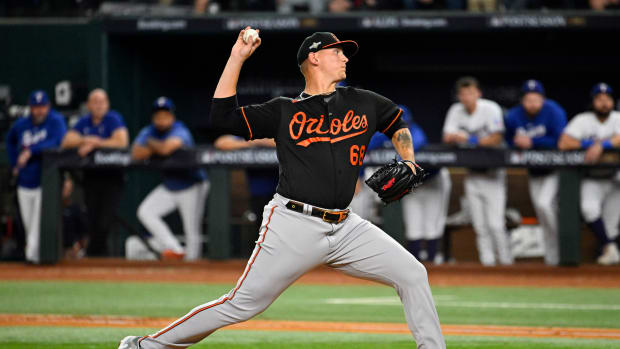For first-place Yankees, best move at trade deadline is not making one
Two things came into sharp focus during the Yankees’ 21–5 curb-stomping of the Rangers on Tuesday night. One, even on a day during which one of their divisional rivals acquiredTroy Tulowitzki, was that New York is going to win the American League East, regardless of the unlikely confluence of factors that has resulted in that reality. Alex Rodriguez and Mark Teixeira have proven not twin, screeching contractual albatrosses but, if anything, underpaid, at least for this year. New York's aging and creaky roster is suddenly entirely healthy, for all intents and purposes. And the Blue Jays, Tulowitzki’s new employer, are somehow a game below .500 despite owning the league’s best run differential. After Tuesday, with 63 games left to play, the Yankees hold a seven-game lead in the division and, according to Baseball Prospectus’s calculations, a better than 82% probability of winning it, up from just 29% less than one month ago. This time of year, that is as sure a thing as things get.
That state of affairs made the second thing clear: that the Yankees ought to be entirely content to allow Friday’s trade deadline to pass them by without doing anything at all.
With unbelievable comeback season, Alex Rodriguez is writing new story
This is not to suggest that the Yankees, as presently constituted, are without holes. They could use a new second baseman—theirs, led by Stephen Drew, have combined to bat a league-worst .193—but with Ben Zobristalready dealt to the Royals, there don’t appear to be any attractive ones on the market. And they could use a frontline starting pitcher to slot in with Michael Pineda and Masahiro Tanaka and, presumably, push CC Sabathia and his 5.38 ERA out of the rotation entirely. There are several of those who likely remain available, including the Tigers’ David Price and the White Sox’ Jeff Samardzija, but with the AL East presumably locked up—and, therefore, the one-game crapshoot that is the Wild-Card Game avoided—the Yankees would really be acquiring either soon-to-be free agent for a maximum of six postseason starts, and a minimum of one.
An argument can be made that Cole Hamels, the Phillies’ ace who is all but certain to be dealt, makes more sense, as he is signed to a not unreasonable contract that will pay him $22.5 million a year through 2018 with a $20 million club option after that. For the Yankees, though, Hamels would also essentially represent a one-to-six-game rental for this October. They, of course, are one of the few clubs with the financial wherewithal to sign any pitcher they want after this season, and the free-agent market promises to include several of Hamels’s abilities, including not only Price and Samardzija but also Johnny Cueto, Zack Greinke and Jordan Zimmermann.
• JAFFE: Royals get much-needed ace with trade for Johnny Cueto
In other words, whatever juice the Yankees might derive from adding a big name by Friday’s deadline would almost certainly not be worth the squeeze—one which would come in the form of the top prospect or two the club would have to sacrifice to acquire him. Say what you want about Brian Cashman’s 18 years as the Yankees' general manager, but one area in which he has undeniably excelled has been in the evaluation of his own prospects.
Troy Tulowitzki trade debate: Who won, what's next for Jays and Rockies
Due to a combination of perennially low draft picks and amateur scouting that might have produced better results than it has, the Yankees’ minor league system hasn’t exactly overflowed with blue chippers during Cashman’s tenure, but it has been rare that he has traded away a prospect that has come back to bite him. For every one that has elsewhere developed into a serviceable major leaguer, like Jake Westbrook, Ian Kennedy and Austin Jackson, there seem to be a half-dozen Brandon Claussens and Shane Greenes and Jeff Marquezes and Jesus Monteros and Hector Noesis who have not. Meanwhile, the prospects onto whom Cashman has steadfastly held—like Robinson Cano, Brett Gardner and even Ivan Nova—have tended to work out rather well.
So, when Cashman recently deemed a quartet of his current minor leaguers to be “untouchable”—first baseman Greg Bird, outfielder Aaron Judge, shortstop Jorge Mateo and righthanded pitcher Luis Severino—we might take that to mean that he genuinely believes he finally has a bumper crop growing down on the farm. We might also conclude that Cashman is comfortable allowing the trade deadline to elapse without making a move, as it would likely take one of the four to bring back anyone of any repute. Of course, Cashman’s assertion of their untouchability might be a negotiating tactic. It ought to be more than that. The Yankees might make a tweak or two before Friday, and they might even add a star if his price falls low enough, but they shouldn’t if means sending away Bird, Judge, Mateo or Severino, or second baseman Rob Refsnyder or catcher Gary Sanchez, either.
For the first time in years, and as improbable as it seemed only four months ago, the Yankees are not only healthy, but also have a strong prognosis. You need not perform surgery on a patient like that.


































